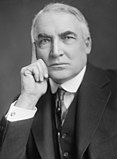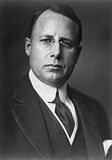| |||||||||||||||||||||||||||||||||
| |||||||||||||||||||||||||||||||||
 County Results
Harding 50-60% 60-70% 70-80% 80-90%
| |||||||||||||||||||||||||||||||||
| |||||||||||||||||||||||||||||||||
| Elections in Wisconsin |
|---|
 |
The 1920 United States presidential election in Wisconsin was held on November 2, 1920, as part of the 1920 United States presidential election. State voters chose 13 electors to the Electoral College, who voted for president and vice president.
Wisconsin had ever since the decline of the Populist movement been substantially a one-party state dominated by the Republican Party.[1] The Democratic Party became entirely uncompetitive outside certain German Catholic counties adjoining Lake Michigan as the upper classes, along with the majority of workers who followed them, completely fled from William Jennings Bryan's agrarian and free silver sympathies.[2] As Democratic strength weakened severely after 1894 – although the state did develop a strong Socialist Party to provide opposition to the GOP – Wisconsin developed the direct Republican primary in 1903 and this ultimately created competition between the "League" under Robert M. La Follette, and the conservative "Regular" faction.[3]
The beginning of the 1910s would see a minor Democratic revival as many La Follette progressives endorsed Woodrow Wilson,[4] but this flirtation would not be long-lasting as Wilson's "Anglophile" foreign policies were severely opposed by Wisconsin's largely German- and Scandinavian-American populace.[5] The 1918 mid-term elections saw the Midwestern farming community largely desert the Democratic Party due to supposed preferential treatment of Southern farmers:[6] Democratic seats in the Midwest fell from thirty-four to seventeen,[7] whilst Scandinavian-Americans were also vigorously opposed to entering the war.[8] Furthermore, Democratic fear of Communism seen in the Palmer Raids and "Red Scare" led to ultimate nominee James M. Cox, then Governor of Ohio, to ban German-language instruction in public schools in 1919.[7] Still more critical for German-Americans was the view that outgoing President Woodrow Wilson was deliberately trying to punish Germany and Austria for starting the war, especially via his disregard for the United Kingdom's continuing blockade of Germany.[9] Stressing Harding's German ancestry, the German press drummed up the view that
- ^ Burnham, Walter Dean; 'The System of 1896: An Analysis'; in The Evolution of American Electoral Systems, pp. 178-179 ISBN 0-313-21379-8
- ^ Sundquist, James; Politics and Policy: The Eisenhower, Kennedy, and Johnson Years, p. 526 ISBN 0-8157-1909-4
- ^ Hansen, John Mark; Shigeo Hirano, and Snyder, James M. Jr.; 'Parties within Parties: Parties, Factions, and Coordinated Politics, 1900-1980'; in Gerber, Alan S. and Schickler, Eric; Governing in a Polarized Age: Elections, Parties, and Political Representation in America, pp. 165-168 ISBN 978-1-107-09509-0
- ^ Crews, Kenneth D.; 'Woodrow Wilson, Wisconsin, and the Election of 1912'; Presidential Studies Quarterly, Vol. 12, No. 3: 'Presidents, Vice Presidents and Political Parties: Performance and Prospects' (Summer, 1982), pp. 369-376
- ^ Leary, William M. (jr.); 'Woodrow Wilson, Irish Americans, and the Election of 1916'; The Journal of American History, Vol. 54, No. 1 (June 1967), pp. 57-72
- ^ Morello, John A.; Albert D. Lasker, Advertising, and the Election of Warren G. Harding, p. 64 ISBN 0-275-97030-2
- ^ a b Hough, Jerry F.; Changing Party Coalitions: The Mystery of the Red State-Blue State Alignment, pp. 86-87 ISBN 0-87586-409-0
- ^ Saldin, Robert P., 'World War I and the System of 1896' (2010); Political Science Faculty Publications, Paper 1, pp. 825-836
- ^ Lichtman, Allan J.; Prejudice and the Old Politics: The Presidential Election of 1928, pp. 102, 115


